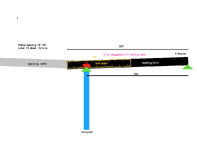Engibeer801
Mechanical
- Feb 17, 2025
- 6
Im a PE in mechanical, and I have a friend who asked me to look at some shoddy work done by a contractor. A central beam was replaced in his building due to water damage, and when the contractor took the beam out, they saw that maybe 10-11 of the 2x10 rafters (which span 18ft) had rotted out where they rested on the beam. The contractor simply took new 2x10s that were 9ft long, and nailed them onto the existing rafters to extend new wood over the new central beam. Im sure this can't be sufficient, and I have suggested that full length replacements be installed, but he is very hesitant because says there is a lot of duct work, air lines, and electrical that will have to be dealt with, and he is already over budget and battling with other problems caused by the same contractor.
Analyzing spliced rafters isn't something I am very familiar with. I really want to help him out with a cheap solution, so I am wondering if there is there a guideline or some literature on bolting patterns that would help me come up with a proper solution? It would seem like I really just need to focus on the shear force as we are talking about the ends of the members, but I want to be certain about the length and bolt pattern of the splice.
Can anyone point me in the right direction?
Analyzing spliced rafters isn't something I am very familiar with. I really want to help him out with a cheap solution, so I am wondering if there is there a guideline or some literature on bolting patterns that would help me come up with a proper solution? It would seem like I really just need to focus on the shear force as we are talking about the ends of the members, but I want to be certain about the length and bolt pattern of the splice.
Can anyone point me in the right direction?

